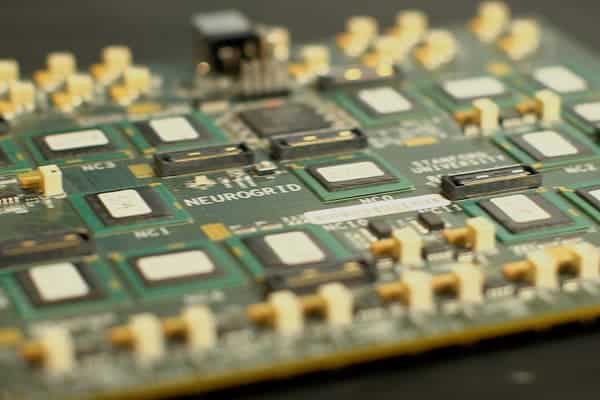
The Neurogrid circuit board can simulate orders of magnitude more neurons and synapses than other brain mimics on the power it takes to run a tablet computer. Photo: Stanford
A mouse might not look like the smartest animal, but however modest its cortex may seem it’s still 9,000 times faster than a personal computer simulation of its functions. Not only that, but it takes 40,000 times more power to run – energy efficiency being, in fact, the true benchmark that needs to be considered when comparing brains to computers. You can imagine what kind of complexity and challenges are faced by a computer trying to model the human brain.
Exploiting biotechnology developed over the past 15 years, Stanford engineers have developed a novel circuitboard that is tuned to run simulations of the human brain with remarkable efficiency. According to the team, the circuitboard runs 9,000 times faster and uses significantly less power than a typical PC. Such technology could prove to be essential to future efforts involving human brain modeling, but a more practical and immediate use might be integration with smart prosthetic limbs that move and respond akin to a functioning, biological limb.
[READ] Bionic prosthetic allows disabled to run, climb and even dance – watch this TED talk!
Called the Neurogrid, the circuit board consists of 16 custom-designed “Neurocore” chips, which together simulate 1 million neurons and billions of synaptic connections. The computing density is so large that everything fits in a circuitboard the size of an iPad, but power efficiency wasn’t neglected either – the device simulates orders of magnitude more neurons and synapses than other brain mimics on the power it takes to run a tablet computer.
The Neurogrid costs about $40,000, but Kwabena Boahen, associate professor of bioengineering at Stanford, hopes that by scaling it to mass manufacturing, the price could go down to as low as $400, cheap enough maybe to be integrated with smart prosthetic. Add a compiler software to the equation (at the moment, a programmer needs to know neurology and how brain components act together to write a software for the Neurogrid), which will allow non-neuroscientists to write code for the board, and these neuromorphic systems could find numerous applications. Boahen envisions a Neurocore-like chip that could be implanted in a paralyzed person’s brain, interpreting those intended movements and translating them to commands for prosthetic limbs without overheating the brain. Efforts such as these are already in place at Boahen’s lab.
The researchers do not kid themselves, however. The challenges and work ahead of them are immense. In his article (Proceedings of the IEEE), Boahen notes that Neurogrid is about 100,000 times more energy efficient than a personal computer simulation of 1 million neurons. Yet it is an energy hog compared to our biological CPU.
“The human brain, with 80,000 times more neurons than Neurogrid, consumes only three times as much power,” Boahen writes. “Achieving this level of energy efficiency while offering greater configurability and scale is the ultimate challenge neuromorphic engineers face.”









